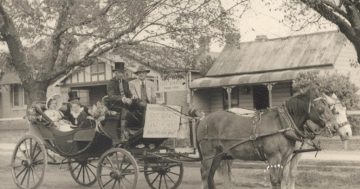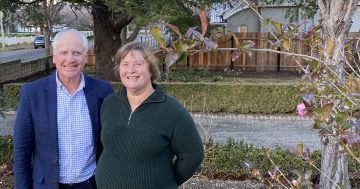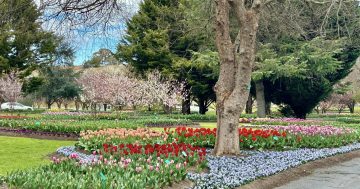
Lilacs are superb when they flower, as Bradfordville resident Leon Oberg found in a previous spring, capturing this photo. Photo: Leon Oberg.
Well-suited to Goulburn’s weather extremes, lilac trees offer a spectacular display of spring flowers. But this perennial favourite is sometimes late to bloom, depriving the Lilac City Festival of celebrating its soft beauty.
Former lilac festival gardening judge John Weatherstone, who earned his horticultural credentials developing the pioneering Gunning property Lynfield Park, is not hopeful of blooms in time for the Festival’s October long weekend.
“I think they might be a bit late because we have had so little sunny weather; I think they may not make it,” he says.
John says lilac is his favourite perfume. He recalls most Goulburn gardens he visited while judging had at least one lilac tree; some had up to 12. He awarded bonus points for having lilacs and points for other lilac-coloured plants.
One of this year’s garden competition judges, Sue Mowle will be looking for lilac trees and lilac colours in entrants’ gardens.
The Garden Clubs of Australia zone coordinator and Goulburn Garden Club member will also be looking at the styles of gardens, from cottage to native, formal, established or new.
Sue isn’t expecting the lilacs to be in bloom during the pre-festival judging.
“I was told – and I am not an expert – that the old-style lilac trees always flowered earlier. People have told me all along Sloane Street there were lilacs and they were always out for lilac time,” she says.
“Whether they have hybridised them, I’m not too sure.”
The irregularly blooming lilacs promoted civic leaders to establish a more reliable rose festival, which flourished from the early 1990s when rights to a City of Goulburn rose were secured by resident Jane Pockley.
Nurtured by volunteers and Goulburn Mulwaree Council, which established gardens on verges and in Victoria Park, the festival flourished, only to whither and fold in recent years, leaving the field for lilacs to endure.

John Weatherstone in his well-ordered garden in Goulburn. Photo: John Thistleton.
This year John has put down his judging hat and entered his garden at Nicole Place on the southwest fringe of Goulburn in the lilac competition.
He and Jan have been toiling away for four and a half years. It’s a smaller task than their grazing property Lynfield Park, which they had developed into such a notable sustainable farming showpiece that the then Prince Charles, another noted environmentalist, visited in 2012.
A well-established garden surrounds the Weatherstone’s home in Goulburn. They didn’t want to rip it all out and start again.
John brought spoiled bales of lucerne from the bottom of the hay shed to make temporary vegetable gardens and counted his good fortune that Jan didn’t mind trimming hedges. They have lots of meticulously clipped hedges.
On a sloping, terraced block large eucalypts stand too close to the house but are protected by covenants. The pay-off is in the birdlife.
“In the first two years we were here I imported something like 200 tonnes of various materials, soil and concreting mix,
John says.
“We had a bit of an issue with stormwater. Because we’re on the lower part of quite a steep hill we get massive run-off from areas above us in big storms. We actually had to put in what we call a dry river bed.”
Over time, the addition of retaining walls, espalier fruit trees on top of the bank and 12 tonnes of river stones give the area a more ornamental appearance while still being functional.
The work gave John something to focus on, staving off nostalgia around the farm – but he often thinks about a lovely, dark purple lilac they left there. It had belonged to Jan’s family before the Weatherstones were married.
Everyone in Goulburn seems to have a favourite lilac story, which all come to the fore for the October long weekend festival.
For more information on Goulburn’s Lilac City Festival, visit the Facebook page.













